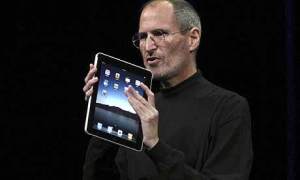Last week, I purchased a 32GB Wi-Fi iPad to my great delight. Since then, it’s become my go-to device for casual Web browsing, E-mailing, and the occasional game. I’ve spent lots of time surfing the App store, reminding me of two years ago when I first purchased my iPhone 3G. In my first week of using Apple’s new device, I’ve come to some conclusions relevant to using the iPad in classrooms.
First, the battery life is stellar. My family can use the iPad on and off for an entire day, from 6am until 10 at night, and still have had no less than 35% battery life remaining. I have no doubt the iPad will last for an entire school day (maybe two) on a single charge.
Second, the interface is child-simple. I have two kids, a daughter aged 4.5 and a son who is 21 months old. I synced the iPad with my computer, and transferred most of my iPhone apps with the iPad. This included games such as Uno and Peggle. I also downloaded Doodle Buddy, a free drawing program and Super Why!, a PBS Kids game. My daughter, a pre-reader (recognizing letters and numbers but not most words), was immediately able to grasp the interface, and within a few minutes could play and switch between Uno and Peggle by herself. She made many drawings and saved them to the iPhoto library with ease. Even my son, who saw us playing, has learned to press the home button and swipe the unlock slider! I have no doubt that any student will be able to operate the interface easily.
Third, this thing is FAST. Apple’s done a great job of keeping the OS streamlined and optimized for its custom processor. Launching apps, returning to the home screen, browsing the Internet, checking email, downloading apps, scrolling, everything responds instantly and accurately to the touch. Kids will be able to spend their time using the iPad working, not waiting for apps to load.
Fourth, syncing an iPad is easy, until I imagine syncing 40 of them. Plugging the iPad into my computer, it quickly syncs programs and data, music and photos, just as I expected having used an iPod and iPhone. Unfortunately, Apple has not announced any kind of lab-management tools with their iPhone OS 4. While it’s certainly not too late for Apple to recognize the value of the education market and release an Apple Remote Desktop-like solution, there has been no indication of any plans so far. The silver lining of the current situation is the fact that Apple’s license allows 5 devices to sync with a single software purchase, but for many iPad lab managers, the ease of use of a remote management system likely overshadows the cost savings.
Finally, there are tons of music apps, but none ideal for the classroom setting… Yet. I’ve downloaded the music game Magic Piano, which is fun, but not a composition or performance tool of much depth. Drum simulators Beatwave and PatternMusic have more potential for creating music, but they’re not really serious composition tools. I’ve downloaded the free piano/organ/rhodes/etc. keyboard app ProKeys, and I was even able to plug into a guitar amp and play some organ licks with my band when our keyboard player was stuck in Paris last week. Of course, this app is only useful if you have some piano skill to begin with. I’ve downloaded Karajan Pro, a $9.99 “Music and Ear Trainer” which is really more of a testing app than a teaching app. For an inexperienced musician, this might help in checking memorization of key signatures and basic intervals, but again, it’s only really useful for testing. I’m still on the lookout for more comprehensive solutions for theory and eartraining instruction. If you’ve found the killer music app, please leave a comment recommending what I should check out!




 Posted by Dave Martin
Posted by Dave Martin 




